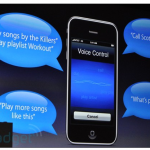That is the Question. Whether it’s driven by state strictures surrounding drivers’ safety or simply a matter of convenience, a growing number of mobile devices have added automated speech. The iPhone GS, which was demo’d at the Apple WorldWide Developers Conference (#wwdc for you hash taggers on Twitter) is no exception.
Automated speech winnowed its way into the iPhone demo in two instances. First was the text-to-speech rendering of driving directions offered by TomTom, whose CTO put on a demo at WWDC. But the coup-de-gras was the unveiling of native “Voice Control”, a feature that delivers a voice-enabled user interface when iPhone users hold down the “Home” button. At that piont, they can use the spoken word to conduct voice-activated dialing, search their iTunes library or enter other commands to their iTunes application.

There are already more than two dozen voice-enabled applications for the iPhone, ranging from stand-alone voice-activated dialing (from the resident contact list) to full-blown dictation of text messages, Tweets or FaceBook entries. All require some sort of manual input (pressing or holding down a button) to let the device know that it is accepting spoken input.
![]() In a move that has been a long time coming, Sensory Inc., has finally packaged its technology to support truly hands-free input to mobile devices. By adding resident “word spotting” technology to its firmware, Sensory enables the makers of Bluetooth devices (specifically wireless headsets, aftermarket “car kits”, and stereo headsets) to sell devices that let their users define phrases that “trigger” speech recognition. As Sensory’s CEO Todd Mozer observes, “”What’s been needed all along is a speech controlled technology that doesn’t require a button press to get started.”
In a move that has been a long time coming, Sensory Inc., has finally packaged its technology to support truly hands-free input to mobile devices. By adding resident “word spotting” technology to its firmware, Sensory enables the makers of Bluetooth devices (specifically wireless headsets, aftermarket “car kits”, and stereo headsets) to sell devices that let their users define phrases that “trigger” speech recognition. As Sensory’s CEO Todd Mozer observes, “”What’s been needed all along is a speech controlled technology that doesn’t require a button press to get started.”
We agree. The products will carry the “BlueGenie” brand. It will enable its users to say a simple wake-up phrase like “Hello BlueGenie” to signal the device to “listen” for an operational speech command. It is a new technology from Sensory that both works well in relatively noisy environments, but most importantly, it uses a “patent-pending” technology to minimize power consumption and avoid rapid battery drain.
We’ll be watching to see how many headset makers, ODMs and OEMs contract to use the Sensory technology. At first it will be a nice differentiator, in the long-run we see it as an important feature to prevent driver distraction.
Categories: Articles

 NiCE Interactions 2025: Agentic AI, Better Data, and a Whole Lot of Partnership
NiCE Interactions 2025: Agentic AI, Better Data, and a Whole Lot of Partnership  Getting It Right: What AI Agents Actually Mean for Customer Support (Webinar)
Getting It Right: What AI Agents Actually Mean for Customer Support (Webinar)  Beyond the Basics: How AI Is Transforming B2B Sales at TP
Beyond the Basics: How AI Is Transforming B2B Sales at TP  Five9 Launches Agentic CX: Toward AI Agents That Reason and Act
Five9 Launches Agentic CX: Toward AI Agents That Reason and Act